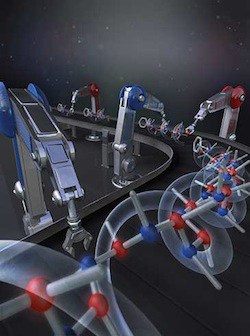
To develop a productive nanosystem for molecular manufacturing/atomically precise manufacturing it would be very useful to have a nanoscale assembly line. A month ago we posted here about a proof of principle for one such assembly line based upon biomolecules. This month Christine Peterson sends word of an assembly line for complex artificial organic molecules. An article on SingularityHUB led to this news release from the University of Bristol “Chemists create ‘assembly-line’ for organic molecules“:
Scientists at the University of Bristol have developed a process where reagents are added to a growing carbon chain with extraordinary high fidelity and precise orientation, thereby controlling the conformation of the molecule so that it adopts a helical or linear shape. The process can be likened to a molecular assembly line.
Nature has evolved highly sophisticated machinery for organic synthesis. One of the most beautiful examples is its machinery for the synthesis of polyketides, a very important class of molecules due to their broad spectrum of biological activities (for example antibiotic, antitumor, antifungal, antiparasitic).
In this process, a simple thioester (small building block) is passed from one enzyme domain to another, growing as it does so until the target molecule is formed. The process resembles a molecular assembly line.
The Bristol researchers sought to emulate nature in the construction of their own molecular assembly line through a related iterative process. But iterative processes are very challenging as each iteration must occur with >99.5 per cent efficiency, and >99.5 per cent stereocontrol otherwise mixtures would result.
In a paper published in the journal Nature today [abstract], the scientists report a reagent which reacts with their small building blocks (boronic esters) with exceptionally high fidelity and stereocontrol.
Through repeated iteration they have converted a simple building block into a complex molecule (a carbon chain with ten contiguous methyl groups) with remarkably high precision over its length, its stereochemistry and therefore its shape.
Different stereoisomers were targeted and it was found that they adopted different shapes (helical/linear) according to their stereochemistry.
This work should now enable molecules with predictable shape to be rationally designed and created which could have an impact in all areas of molecular sciences where bespoke molecules are required.
The ability demonstrated here to control the spatial configuration of the addition of each new subunit of a long molecule to achieve programmable molecular shapes is certainly a useful step toward a molecular assembly line. One interesting question is how many specially designed or specially chosen building blocks and reagents will be needed to construct a generally useful molecular assembly line.
—James Lewis, PhD
